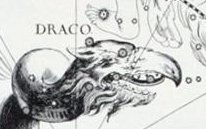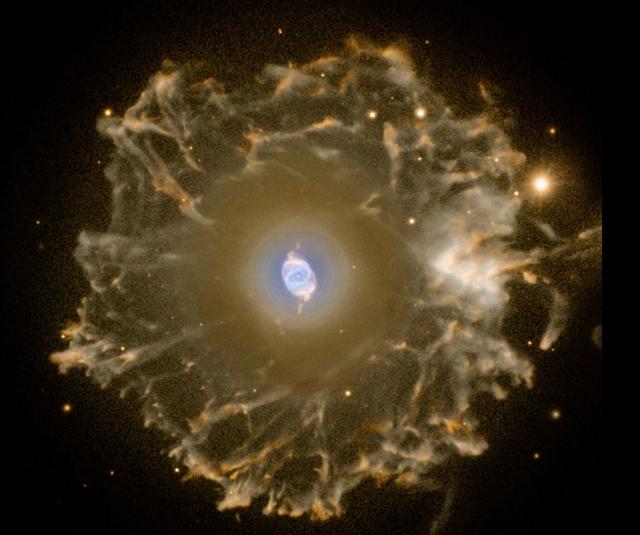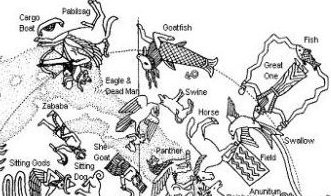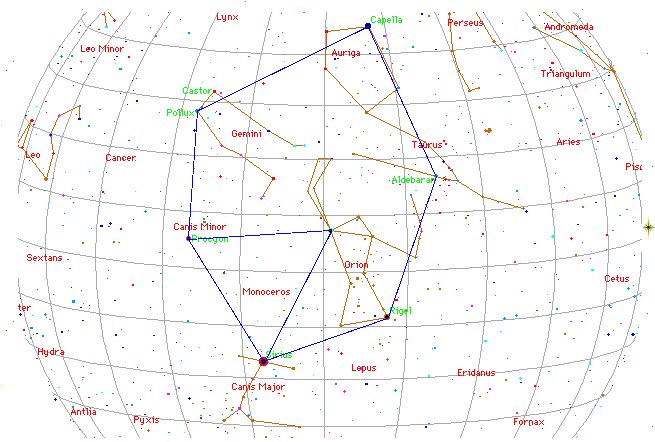The coconut (niu) was a sign of peace, of calm restored
(after a battle preceded by the 'breaking the coconut'):
...For in the ideal ritual calendar, the kali'i
battle follows the autumnal appearance of the Pleiades, by
thirty-three days - thus precisely, in the late eighteenth
century, 21 December, the winter solstice ...
The correspondence between the winter solstice and the kali'i
rite of the Makahiki is arrived at as follows: ideally,
the second ceremony of 'breaking the coconut', when the priests
assemble at the temple to spot the rising of the Pleiades,
coincides with the full moon (Hua tapu) of the twelfth
lunar month (Welehu). In the latter eighteenth century,
the Pleiades appear at sunset on 18 November. Ten days later (28
November), the Lono effigy sets off on its circuit, which
lasts twenty-three days, thus bringing the god back for the
climactic battle with the king on 21 December, the solstice (=
Hawaiian 16 Makali'i). The correspondence is 'ideal' and
only rarely achieved, since it depends on the coincidence of the
full moon and the crepuscular rising of the Pleiades ...
Niu. Palm tree,
coconut tree; hua niu, coconut. Vanaga. Coconut, palm,
spinning top. P Pau., Ta.: niu,
coconut. Mgv.: niu, a
top; niu mea,
coconut. Mq.: niu,
coconut, a top. Churchill. The fruit of
miro. Buck. T. 1.
Coconut palm. 2. Sign for peace. Henry. The sense of top lies in
the fact that the bud end of a coconut shell is used for
spinning, both in the sport of children and as a means of
applying to island life the practical side of the doctrine of
chances. Thus it may be that in New Zealand, in latitudes higher
than are grateful to the coconut, the divination sense has
persisted even to different implements whereby the arbitrament
of fate may be declared. Churchill 2.
| i
tōmo.era.te ngao o oto uta.ki mua ki te hanga. |
After the neck of Oto
Uta had been brought on land, out in the bay of
Hanga Rau, the wind, the rain, the waves, and the
thunder subsided [hē
kōre.te tokerau.te uā.te vave.te hātu.tiri]. |
| ki
hanga rau.hē kōre.te
tokerau.te uā.te vave. |
|
te hātu.tiri.he tuu a
kuihi.a kuaha.he haka(-) |
The stormy sea (ku
rakerake-á a haho a te tai, the sea has
turned rough) was here in the past.
Rake,
rakerake: 1. Bad, ugly, unjust; to
turn nasty (of a situation); ku
rakerake-á a haho a te tai, the sea has
turned rough. 2. To be abundant: ku
rakerake-á te îka, there are lots of
fish. Rakerakega, wickedness. Vanaga.
Bad, in its most general sense; patu
toona rake, immodest, to expose the
person obscenely; rakega, evil,
perversity; rakerake, abominable,
frightful, low, shocking, culpable, crime,
debauchery, dishonor, fault, hideous,
ignoble, deformed, illicit, immodest,
immoral, impious, irreligious, lascivious,
evil, bad, obscene, sinful, ugly;
rakerakega, sin, cirme, fault, impiety,
iniquity, evil, vice; hakarakerake,
causative, to make bad, etc. Pau.:
marakerake, afflicted, disconsolate.
Churchill.
...he
ro korua.e aku hoa e.ki hahati atu te ngao o
te rakerake era
(Let's
go my friends (hoa), let's break the
neck [hahati
atu te ngao]
of this mean one (or, ugly one, rakerake)
...
|
he too mai a Pure ō.i te
pureva.he ava.ki runga |
Pure O picked
up a large round stone (pureva) and hit the top
of the figure. Because of the stone, the neck of Oto Uta
was broken. |
|
ki te moai.he hati te
ngao.o oto uta.i pureva. |
|
he hū te
tokerau.he ketu te vave.he hati te vave. |
Then the wind
started blowing, the billow rose, the waves broke, and
the rain started falling, the flame (i.e., lightning)
shone brightly, and the thunder rolled. |
|
he hoa te
ūa.he nomo mai mai te ura.he hati |
|
he hetu te
patiri. |
|
i hu era te tokerau.i hati
era te vave.i ava |
As soon as the
wind started blowing, the waves broke, the rain fell,
and the thunder rolled, King Hotu knew that Pure O had
done harm to Oto Uta [penei
ē.ku kori ana a Pure ō.i te ariki.i a oto uta]. |
|
era te ua.i hetu era te
hātu.tiri |
|
he angiangi e te ariki.e
Hotu.penei ē.ku kori ana |
|
a Pure ō.i te ariki.i a oto
uta. |
|
he ki a Hotu.ku kori ana
tau ngaio era i te ariki |
Hotu spoke,
'These fellows have done a mean thing [ku
kori ana tau ngaio era] to King Oto Uta!"
|
|
i a oto uta. |
|
i hati era te ngao.o te
ariki o oto uta.he ōho.atu |
After the neck
of Oto Uta had been broken, Kuihi and Kuaha arrived.
They picked up the neck of King Oto Uta, took it, and
brought it with them. |
|
a kuihi.a kuaha.he too mai
i te ngao.o te a(-) |
|
riki o oto uta.he mau he
ōho.mai he tuu ki |
| Gao. 1.
Neck. 2. Glans penis (te gao o te kohio), neck of
penis. Vanaga. Neck, throat, (naho G); gao
pukupuku, scrofula; hore te gao, to cut the
head off; arakea gao, scrofula. Gaogao,
calm. Gaoku, to eat greedily. Gaopu, to
choke on a bone. Churchill. |
We can compare with the
opposite case:
... The father of Aemilianus the orator, to
whom some of you have listened, was Epitherses, who lived in our
town and was my teacher in grammar. He said that once upon a
time in making a voyage to Italy he embarked on a ship carrying
freight and many passengers. It was already evening when, near
the Echinades Islands, the wind dropped and the ship drifted
near Paxi [→ Pax
Romana (Peace of Rome) → 16 Pax]. Almost
everybody was awake, and a good many had not finished theire
afterdinner wine. Suddenly, from the
island of Paxi was heard the voice of someone loudly calling
Thamus [Tammuz, Dumuzi],
so that all were amazed. Thamus was an Egyptian pilot, not known
by name to many on board. Twice he was called and made no reply,
but the third time he answered; and the caller, raising his
voice, said, 'When you come opposite to Palodes, announce that
Great Pan is dead.' On hearing this, all, said Epitherses, were
astounded and reasoned among themselves whether it were better
to carry out the order or to refuse to meddle and let the matter
go. Under the circumstances Thamus made up his mind that if
there should be a breeze, he would sail past and keep quiet, but
with no wind and a smooth sea about the place he would announce
what he had heard. So, when he came opposite Palodes, and there
was neither wind nor wave, Thamus from the stern, looking toward
the land, said the words as he heard them: 'Great Pan is dead'.
Even before he had finished there was a great cry of
lamentation, not of one person, but of many, mingled with
exclamations of amazement. As many persons were on the vessel,
the story was soon spread abroad in Rome, and Thamus was sent
for by Tiberius Caesar. Tiberius became so convinced of the
truth of the story that he caused an inquiry and investigation
to be made about Pan; and the scholars, who were numerous at his
court, conjectured that he was the son born of Hermes and
Penelope ...
The canoe of Pure O left Easter Island in "November 5
(Ruti 5), i.e. in right ascension day *229 (= 309 - 80).
From the time-frame of Bharani to that of rongorongo there
were *41 precessional right ascension days, which means the stars rising heliacally
should have moved ahead in the Sun calendar with 41 days
since the time when the star Bharani was at 0h,
viz. to
day 309 + 41 = 350 (*270):
|
OCT 11 |
12 |
13 |
14
(*207) |
15 (288) |
 |
 |
 |
 |
 |
|
Ga8-1 |
Ga8-2 |
Ga8-3 |
Ga8-4 |
Ga8-5
(208) |
|
KELB ALRAI (Dog of the Shepherd) = β Ophiuchi,
μ
Arae (268.1),
KEW
HO (Nine Rivers) = μ Herculis
(268.6),
η
Pavonis (268.7),
APOLLYON
=
ι
Scorpii
(268.9)
*231.0 - *4.0 = *227.0 |
MULIPHEN (Oaths) = γ Ophiuchi
(269.0),
BASANISMUS = G Scorpii
(269.5),
PHERKARD (Dim One of the Two Calves) = δ Ursae
Minoris
(269.9) |
PTOLEMY CLUSTER
= M7 Scorpii
(270.5),
GRUMIUM
(Lower Jaw) = ξ Draconis
(270.9)
*227.0 + *2.0 = *229.0
270 - 229 = 41 |
RUKBALGETHI GENUBI (Bending Claw) = θ Herculis
(271.1),
ξ
Herculis (271.5),
ETAMIN (Head) = γ Draconis,
ν
Herculis (271.7),
ν
Ophiuchi (271.8) |
CAT'S EYE
= NGC6543 Draconis
(272.2),
ζ
Serpentis (272.4),
τ
Ophiuchi (272.9)
*231.0 = *272.4 - *41.4 |


 |
|
Dec 14
(*268) |
15 |
16 (350) |
17 |
18 |
|
°Dec 10
(*264) |
11 (345) |
12 |
13 |
14 |
|
'Nov 17
(*241) |
18 |
19 |
20 (324) |
21 |
|
"Nov 3
(*227) |
4 |
(Ko) Ruti 5 |
6 (310) |
7 |
|
CLOSE TO THE FULL MOON: |
|
ο Aurigae (85.8), γ Leporis (85.9)
YANG MUN (α Lupi) |
μ
Columbae,
SAIPH (Sword) =
κ
Orionis
(86.5),
τ
Aurigae,
ζ
Leporis (86.6) |
υ
Aurigae (87.1),
ν
Aurigae (87.2),
WEZN (Weight) =
β
Columbae,
δ
Leporis (87.7),
TZE (Son) =
λ
Columbae
(87.9) |
Ardra-6 (The Moist One) /
ANA-VARU-8 (Pillar to sit by)
χ¹ Orionis,
ξ
Aurigae (88.1),
BETELGEUZE
=
α
Orionis
(88.3),
ξ
Columbae (88.5),
σ
Columbae (88.7) |
η
Leporis (89.0),
PRAJA-PĀTI (Lord of Created Beings) =
δ
Aurigae, MENKALINAN (Shoulder of the Rein-holder) =
β
Aurigae, MAHASHIM (Wrist) =
θ
Aurigae,
and
γ
Columbae (89.3),
π
Aurigae (89.4),
η
Columbae (89.7)
*48.0 = *89.4 - *41.4
μ Orionis
(90.3),
χ² Orionis
(90.5) |
 |
 |
 |
 |

 |
|
Ga1-21 |
Ga1-22 |
Ga1-23 |
Ga1-24 |
Ga1-25
Ga1-26 |
 |
There are 229 glyphs on side a of the G tablet:
|
16 |
NOV 1 |
2 (306) |
3 (*227) |
4 |
→ Ko Ruti 5 |
 |
 |
 |
 |
 |
|
Ga8-22
(15 * 15) |
Ga8-23 |
Ga8-24
(227 → π) |
Ga8-25 |
Ga8-26
(229) |
|
19h (289.2)
λ
Aquilae (Ant.) (289.1),
γ
Cor. Austr (289.3),
τ
Sagittarii (289.4),
ι
Lyrae (289.5),
δ
Cor.
Austr. (289.8)
*248.0 = *289.4 - *41.4 |
Al Baldah-19 (City)
AL
BALDAH
= π Sagittarii,
ALPHEKKA
(Dish) MERIDIANA = α Cor. Austr.
(290.1), β Cor. Austr. (290.2) |
ALADFAR
(The Talons) = η Lyrae
(291.1),
NODUS II = δ Draconis
(291.5), ψ Sagittarii (291.6), τ Draconis (291.7), θ
Lyrae (291.8) |
ω Aquilae (292.1), ρ Sagittarii (292.6), υ
Sagittarii (292.7) |
π Draconis,
ARKAB PRIOR = β¹ Sagittarii
(293.0),
ARKAB POSTERIOR = β² Sagittarii,
ALRAMI
(The Archer) = α Sagittarii
(293.2), χ Sagittarii (293.6) |
|
"η, a
4.4-magnitude, is Aladfar in the Century
Atlas, by some confusion with the star μ; and with
θ, of the same brilliancy, was, in China, Lëen
Taou, Paths within the Palace Grounds. μ, of the
5th magnitude, was Kazwini's Al Athfār, the
Talons (of the Falling Eagle), which he described as
a fainter star in front of the bright one, i.e. west
of Wega." (Allen)


Down in the Underworld, where the
Sun moves from the evening (autumn equinox) to the
morning (spring equinox), he apparently goes
counterclockwise, from his old age to his rebirth.
This 'time reversal' was evidently beginning where Sagittarius
stopped all clockwise movements. Alrami (α
Sagittarii) was 2 days after Aladfar (η
Lyrae) and 15 days after Al Athfār (μ
Lyrae). The letter η was like the mirror of the
letter μ (→ water).
 |
|
Jan 4 |
5 (*290) |
6 |
7 (372) |
8 |
|
°Dec 31 |
°Jan 1 |
2 (*287) |
3 (368) |
4 |
|
'Dec 8 |
9 |
10
(*264) |
11 (345) |
12 |
|
"Nov 24 |
25 (329) |
26
(*250) |
27 |
28 |
|
CLOSE TO THE FULL MOON: |
|
MAY 3
(123) |
4 |
5 (*45) |
6 (*411) |
7 (492) |
|
WEZEN (Weight) =
δ
Canis Majoris
(107.1),
τ
Gemini (107.7),
δ
Monocerotis (107.9) |
no star listed (108) |
λ Gemini (109.4),
WASAT (Middle) = δ Gemini (109.8)
*68.0 = *109.4 - *41.4 |
no star listed (110) |
ALUDRA (Virgin) = η Canis Majoris
(111.1),
PROPUS = ι Gemini
(111.4),
GOMEISA (Water-eyed) = β Canis Minoris (111.6)
*70.0 = *111.4 - *41.4 |
|
July 6
(*107) |
7 |
8 |
9 (190) |
10 |
|
°July 2 |
3 (184) |
4 |
5 |
6 (*107) |
|
'June 9 |
10 (161) |
11 |
12 |
13 (*84) |
|
"May 26 |
27 |
28 (148) |
29 |
30 (*70) |
 |
 |
 |
 |
 |
|
Ga2-13 |
Ga2-14 |
Ga2-15
(45) |
Ga2-16 |
Ga2-17 |
The pair of hulls of the Sun canoe were unbound after king
Hotu had arrived to Easter Island in "October 15
(288):
...On the fifteenth day of the month of
October (tangaroa uri), Nonoma left the house [he
ea mai roto i te hare] during the night [i te po]
to urinate outdoors [ki kaho.mimi].
At this point Ira called out [he rangi]
to Nonoma, 'Look at the canoe!'
Nonoma ran [he tahuti], he quickly went to Te Hiringa
Heru (a ravine in the side of the crater Rano Kau) and
looked around. There he saw the double canoe way out near
the (offshore) islets [i te motu o haho], and the two
(hulls of the canoe) were lashed together.
He ran and returned [he tahuti he hoki]
to the front of the house [ki te mua ki te hare].
He arrived and called [he tuu he rangi] into the
house [a roto i te hare], 'Hey you! This canoe has
arrived during the night without our noticing it!'
Ira asked [he ui] Nonoma,
'Where is the canoe, which you say is lying out there (in
the water)?'
Nonoma's voice [te reo] came back [he hakahoki]:
'It is out there (in the water) close to the (offshore)
islets! There it lies [e noho mai nei], and the two
(hulls) are lashed together.' The
four of them (corrected for 'the six of them') went out and
picked up [he too] leaves (on branches) to give
signals. They picked them up, went and arrived at Te Hikinga
and saw the canoe.Ira
remained at the house [i roto ana i te hare a Ira]
after the four (corrected for 'the six') had gone [i oho
era] to Te Hikinga Vae (sic). [E:75]
... Ira said [he kī a Ira]
to Raparenga, 'Give signals [ka rapu koe] and
tell this [ka hakamaa.penei]: If the canoe continues
[ana oho.te miro] to the right side [a te rara
mata'u] (of Easter Island, seen from Motu Nui), they
should sail way out [a haho ana ana oho] because of
Tama, an evil fish with very long nose [he ika kino.he
ihu roroa] (this is a wordplay with the place name on
the southeastern shore, which 'demands bad victims because
of his cliffs').'
He waved, waved, waved [?], and waved. The one on
board the boat saw [he tikea e runga e te miro]
Raparenga's waving [te rapunga.o Raparenga]
and understood. The signals arrived [he angiangi] on
board the canoe [he iri mai te rapu o runga i te miro];
the waving arrived below [he topa ki raro.te rapu]
(i.e.. in the west). [(Here they) died out, he oti.]
he ki a Hotu The two hulls were no
longer kept lashed together (i.e., they were separated for
the rest of the journey). Hotu called out [he rangi]
to the canoe of the queen [te aríki tamahahine]:
'Steer the canoe to the left side [a te rara maúi]
when you sail in. Teke will jump over on board (your) canoe
to work his mana [hakamanamana] when you sail
[mo oho.atu] through the fishing grounds [i te
hakanononga]!' [I will go (koau ma oho) to the
right (a te rara mata'u), working mana (mo
hakamanamana) when going through the fishing grounds (mo
oho atu i te hakanononga).]
[E:77]
Teke jumped on board the second [he teki.a Teke.ki runga
ki te rua] canoe, (that) of the queen. The king's canoe
[te miro o te ariki. tamaaroa] sailed to the right,
the queen's [to te ariki. tamahanine] to the left ...
[E:78]
The men on board [o runga]
the royal canoe looked out [he ui] from Varinga Te
Toremo (the northeastern cape of the Poike peninsula). There
they saw [he tikea] the canoe of the queen, the canoe
of Ava Rei Pua, as it reached [ka tuu] Papa Te Kena
(on the northern shore, east of Hanga Oteo). Honga came and
gazed in the direction below (i.e., toward the west). He
called out [he rangi] to the noteworthy ruler (?
ariki motongi) Hotu, 'There is the canoe of the queen!
It will be the first one to land! [he rae ka tomo
era]' At this news King Hotu replied to Honga, 'Recite (rutu)
(powerful incantations) as though the ten brothers of the
chief (ariki maahu) were one whole(?).' The ten
recited with all their might. [he rutu korua atatahi te
angahuru] This is what they recited [penei i rutu ai]:
'Let all movement (? konekone) cease!' [ka hakamau
te konekone]. They recited and sailed on swiftly [he
rutu he oho mai]: Honga, Te Kena, Nuku Kehu, Nga Vavai,
Oti, Tive (corrected for Sive), Ngehu, Hatu, Tuki, and Pu
(corrected for Bu). [E:79]
Presumably the creators of Manuscript E were referring to
the situation after the Winnowing Basket (where time
suddenly would turn around and go from very old to very young) -
from the (dry) basket to the (wet) bucket so to say.


At the time of the Bull the Winnowing Basket (Nash =
γ Sagittarii) would have risen simultaneously with
the Sun in OCTOBER 16 (289) :
|
OCT 16 |
17 (290) |
18 |
19 |
 |
 |
 |
 |
|
Ga8-6 |
Ga8-7 (210) |
Ga8-8 |
Ga8-9 |
|
CLOSE TO THE SUN: |
|
Winnowing Basket-7 (Leopard)
18h (273.4)
*232.0 = *273.4 - *41.4
NASH
(Point) =
γ
Sagittarii
(273.7),
θ
Arae (273.8) |
ZHŌNGSHĀN =
ο
Herculis
(274.0),
π
Pavonis (274.6) |
ι Pavonis (275.1),
POLIS = μ Sagittarii
(275.9)
MENKAR (α Ceti) |
η Sagittarii (276.9) |
 |
|
Dec 19 (*273) |
20 (354) |
SOLSTICE |
22 |
|
°Dec 15 (*269) |
16 (350) |
17 |
18 |
|
'Nov 22 (*246) |
23 |
24 |
25 (329) |
|
"Nov 8 (*232) |
9 |
10 (314 =
355 - 41) |
11 |
|
CLOSE TO THE FULL MOON: |
|
APRIL 17 (107) |
18 |
19 |
20 (*30) |
 |
 |
 |
 |
|
Ga1-27 |
Ga1-28 |
Ga1-29 |
Ga1-30 |
|
6h (91.3)
ν
Orionis (91.4),
θ
Columbae (91.5),
π
Columbae (91.6)
*50.0 = *91.4 - *41.4 |
ξ Orionis
(92.5) |
Al Han'ah-4 (Brand) /
Maru-sha-pu-u-mash-mashu-7 (Front of the
Mouth of the Twins)
TEJAT PRIOR
=
η
Gemini
(93.4),
γ
Monocerotis (93.5),
κ
Aurigae (93.6),
κ
Columbae (93.8)
*52.0 = *93.4 - *41.4 |
FURUD
= ζ Canis Majoris
(94.9) |
 |
And the Child of Waters would have risen heliacally
in AUGUST 2 (214), i.e. 75 days earlier:
|
JULY 31 |
AUG 1 |
2 (214) |
3 |
4 (*136) |
5 |
6 |
 |
 |
 |
 |
 |
 |
 |
|
Ga5-22 |
Ga5-23 |
Ga5-24 |
Ga5-25
(135) |
Ga5-26 |
Ga5-27 |
Ga5-28 |
|
δ
Muscae (196.5),
VINDEMIATRIX
(Grape Gatherer) =
ε
Virginis
(196.8 |
13h (197.8)
ξ¹ Centauri (197.1), ξ² Centauri
(197.9) |
APAMI-ATSA
(Child of Waters) =
θ
Virginis,
ψ
Hydrae (198.5),
DIADEM
=
α
Com. Ber.
(198.9) |
AL DAFĪRAH
(Tuft) = β Com. Ber.
(199.4)
*158.0 = *199.4 - *41.4
|
σ Virginis (200.4)
*159.0 = *200.4 - *41.4 |
γ Hydrae (201.0), ι Centauri (201.4)
*160.0 = *201.4 - *41.4 |
Al Simāk-12 (Lofty) /
Chitra-14 (Bright One) /
Horn-1 (Crocodile) /
Sa-Sha-Shirū-20
(Virgin's Girdle) /
ANA-ROTO-3 (Middle pillar)
MIZAR =
ζ
Ursae Majoris
(202.4),
SPICA
=
α
Virginis,
ALCOR
= 80 Ursae Majoris
(202.7)
SADALMELIK (α Aquarii)
*161.0 = *202.4 - *41.4 |
|
Oct 3 |
4 |
5 |
6 |
7 (*200) |
8 |
9 (282) |
|
°Sept 30 |
°Oct 1 |
2 |
3 (275) |
4 (*196) |
5 |
6 |
|
'Sept 6 |
7 (250) |
8 |
9 |
10 |
11 |
12 (*175) |
|
"Aug 23 |
24 (236) |
25 |
Hora Iti 26 |
27 |
28 |
Hora Iti 29 |
|
... On the twenty-sixth day of the
month of August ('Hora Iti') they
went from Papa O Pea to Ahu Akapu
... [E:30]
... They made camp [he
noho] and rested [he hakaora]
at Ahu Akapu for two days. On the
twenty-ninth day of the month of
August ('Hora Iti') they went on to
Pu Pakakina. They arrived, remained
there, and gave the name 'Pu
Pakakina A Ira'. They remained one
month in Pu Pakakina ...
[E:31]
|
45 days (= 365 - 320) |
|
7 days |
5 days |
1 day |
27 days |
5 days |
|
"July 11 (192) |
6 |
"July 18 (199) |
4 |
"July 23 (204) |
"July 24 (205) |
25 |
"Aug 19 (231) |
"Aug 20 (232) |
4 |
|
Te Anakena 11 |
Te Anakena 18 |
Te Anakena 23 |
Te Anakena 24 |
Hora Iti 19 |
Hora Iti 20 |
|
Hanga Takaure |
Hanga Hoonu |
Rangi Meamea |
Oromanga |
Papa O Pea |
| Ga4-6 (89) - (95) |
Ga4-13 (96) - (100) |
Ga4-18 (88 + 13) |
Ga4-19 (102) - (128) |
(129) - (133) |
| Cb6-12 (127) - (233) |
Cb6-19 (134) - (138) |
Cb6-24 (18 * 29½) |
Cb6-25 (140) - (166) |
(167) - (171) |
... Their last day in Papa O Pea was 8 * 29½ = day 236 counted from "January 1, i.e. "August 24. Maybe there was a kind of leap day between "August 24 (236) and "August 26 (238).
|
|
CLOSE TO THE FULL MOON: |
|
JAN
29 |
30 |
31 |
FEBR 1 |
2 |
3 |
4 (400) |
|
φ4 Ceti (13.2) |
no star listed (14) |
1h (15.2)
β Phoenicis (15.1), υ Phoenicis, ι
Tucanae (15.6), η Ceti, ζ Phoenicis
(15.7) |
Al Batn Al Hūt-26 (Belly of the
Fish) /
Revati-28 (Prosperous) /
1-iku (Field Measure)
MIRACH
(Girdle) =
β
Andromedae, KEUN MAN MUN (Camp's
South Gate) =
φ
Andromedae
(16.0),
ANUNITUM
=
τ
Piscium
(16.5),
REVATI
(Abundant) =
ζ
Piscium
(16.9)
REGULUS
(α Leonis) |
ν Phoenicis (17.4), κ Tucanae (17.6)
*342.0 = *383.4 - *41.4
= *159.0 + *183.0 |
no star listed (18) |
ADHIL
(Garment's Train) =
ξ
Andromedae
(19.3),
θ
Ceti (19.7) |
|
April 3 |
4 |
5 (460) |
6 |
7 |
8 |
9 (*384) |
|
°March 30 |
31 |
°April 1 (91) |
2 |
3 |
4 |
5 |
|
'March 7 |
8 |
9 |
10 (*354) |
11 |
12 |
13 (72) |
|
"Febr 21 |
22 |
23 (54) |
24 (*340) |
25 |
26 |
27 (2 * 29) |
|


























